#196: Hygrophoropsis aurantiaca, The False Chanterelle
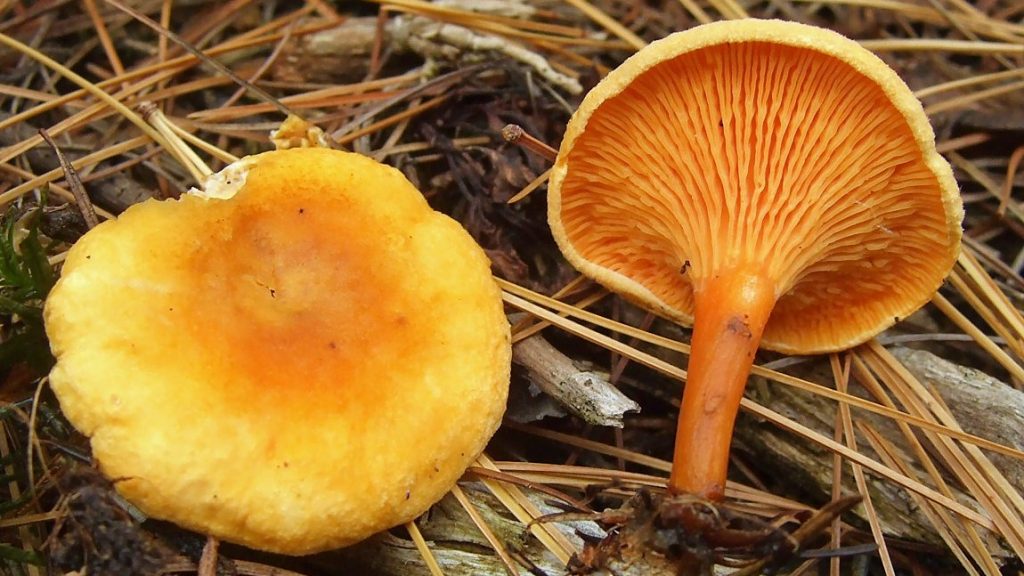
Hygrophoropsis aurantiaca, the False Chanterelle, can sometimes be mistaken for golden chanterelles. This mistake can be avoided because the False Chanterelle grows on woody debris, has true gills, and has a fuzzy cap. Photo by: Bubulcus and Ak ccm [CC BY 3.0 or CC BY-SA 3.0], via Wikimedia Commons (cropped).
Description
The False Chanterelle is a medium-sized umbrella-shaped mushroom with an orangish pileus that makes this mushroom fairly easy to spot. H. aurantiaca’s pileus grows 2-9cm across and is generally round with an inrolled margin.1–4 Slight waves or indents along the margin may distort its shape slightly.2 The cap is often depressed in the center and may even get slightly funnel-shaped.2,4 H. aurantiaca exhibits a lot of variation in pileus color; it ranges from pale orange to bright orange to orange-brown but the center is almost always darker with brown shades. The entire surface of the cap is covered in a fine velvety fuzz that makes it feel quite soft.1–4
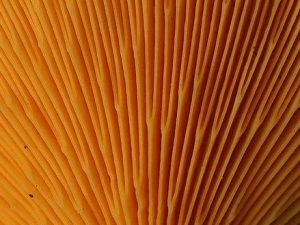
The gills of H. aurantiaca are frequently and repeatedly forked. Photo by: Jason Hollinger [CC BY 2.0], via Wikimedia Commons (cropped).
The stipe of H. aurantiaca grows 2-7cm tall and less than 1cm thick. It is usually the same color as the cap but can be lighter or darker.1–4 The stipe can be smooth or somewhat velvety and may have tiny scales near where it meets the gills.1,2 H. aurantiaca usually forms a base that is slightly swollen and is covered in white threads of mycelium.1
Ecology
H. aurantiaca is saprobic, decomposing debris from conifer trees. On the ground, it extracts energy from leaves, sticks, twigs, and anything else conifer trees drop. It can also grow on conifer logs, but the logs are usually well-decayed by the time the False Chanterelle colonizes them. You can find H. aurantiaca fruiting singly or in small groups from summer through fall (or fall to winter in California). The mushrooms appear all across North America and Europe.1,2
Similar Species
As its common name suggests, the False Chanterelle is very similar in appearance to true chanterelles. In particular, it could easily be mistaken for a golden chanterelle (Cantharellus cibarius group, FFF#101) by an overzealous collector. There are two key differences between H. aurantiaca and golden chanterelles: H. aurantiaca grows on woody debris and it has true gills.1,2,4
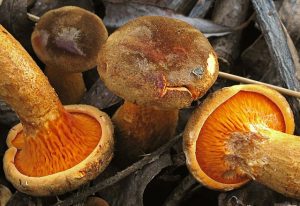
The False Chanterelle often appears to be terrestrial, but it can be easily removed from the ground because it is attached to forest litter and not the soil. The velvety texture of the pileus is visible in this picture. Photo by: Byrain and Ak ccm [CC BY-SA 3.0 or CC BY-SA 3.0], via Wikimedia Commons.
If you flip a chanterelle over, its spore producing surface will be smooth to covered with wrinkles and ridges that at most form “false gills.” False gills have blunt edges that somewhat resemble corrugated cardboard in cross-section. H. aurantiaca, however, features true gills that are pointed on the ends like the edge of a knife. This may sound somewhat nitpicky, but the difference is rather easy to spot once you’ve seen the false gills formed by golden chanterelles.1,2,4
In addition to those differences, H. aurantiaca is generally a flimsier and fuzzier mushroom than golden chanterelles; golden chanterelles tend to have firmer flesh and a smooth pileus.1,2,4
Jack-O-Lantern mushrooms (Omphalotus illudens, FFF#007) also resemble H. aurantiaca and are perhaps more difficult to distinguish than the golden chanterelles. Both mushrooms are orange, grow from wood, and form true gills. Unlike the False Chanterelle, O. illudens is bright orange without shades of brown, has gills that do not fork, and grows in dense clusters. When mature, the Jack-O-Lantern is much larger than the False Chanterelle.3,4 Additionally, O. illudens usually has a sickly sweet odor.
Edibility
The edibility of this species is questionable. Some authors list it as edible, while others describe it as poisonous.4 Apparently some people do eat it without any problems (despite its somewhat bitter taste), but others report gastrointestinal upset.2,3 One site suggests the mushroom occasionally causes hallucinations.2 Its similarity to the Jack-O-Lantern mushroom poses a particular risk for people who choose to eat the mushroom, since the Jack-O-Lantern is poisonous.3 Because of the False Chanterelle’s dubious edibility and because true chanterelles are far superior, mushroom hunters are advised against eating H. aurantiaca.2–4
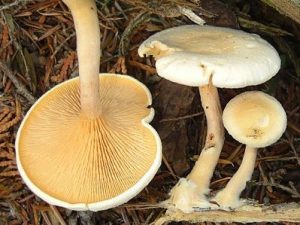
The False Chanterelle is highly variable in color and can even be pale yellow, like this specimen. Photo by: Jason Hollinger and Amada44 [CC BY 2.0], via Wikimedia Commons (cropped).
Taxonomy
H. aurantiaca has been shuffled between numerous genera over the years, but it has remained in Hygrophoropsis since 1921.2 Hygrophoropsis was named for H. aurantiaca’s passing similarity to mushrooms in the genus Hygrophorous, which includes large and mostly pale waxcaps (see FFF#182).2,3 The waxcaps are similar to H. aurantiaca in stature but not much else.2 Despite the name, H. aurantiaca is not related to the waxcaps; it is currently placed in the order Boletales,5 making it more closely related to boletes than to waxcaps and most other agarics.
| Kingdom | Fungi |
| Division (Phylum) | Basidiomycota |
| Subdivision (Subphylum) | Agaricomycotina |
| Class | Agaricomycetes |
| Subclass | Agaricomycetidae |
| Order | Boletales |
| Family | Hygrophoropsidaceae |
| Genus | Hygrophoropsis |
| Species | Hygrophoropsis aurantiaca (Wulfen) Maire5 |
This post does not contain enough information to positively identify any mushroom. When collecting for the table, always use a local field guide to identify your mushrooms down to species. If you need a quality, free field guide to North American mushrooms, I recommend Michael Kuo’s MushroomExpert.com. Remember: when in doubt, throw it out!
See Further:
http://www.mushroomexpert.com/hygrophoropsis_aurantiaca.html
http://www.first-nature.com/fungi/hygrophoropsis-aurantiaca.php
http://www.mykoweb.com/CAF/species/Hygrophoropsis_aurantiaca.html
Citations
- Kuo, M. Hygrophoropsis aurantiaca. MushroomExpert.Com (2015). Available at: http://www.mushroomexpert.com/hygrophoropsis_aurantiaca.html. (Accessed: 25th August 2017)
- O’Reilly, P. Hygrophoropsis aurantiaca (Wulfen) Maire – False Chanterelle. First Nature Available at: http://www.first-nature.com/fungi/hygrophoropsis-aurantiaca.php. (Accessed: 25th August 2017)
- Emberger, G. Hygrophoropsis aurantiaca. Fungi on Wood (2008). Available at: http://www.messiah.edu/Oakes/fungi_on_wood/gilled%20fungi/species%20pages/Hygrophoropsis%20aurantiaca.htm. (Accessed: 25th August 2017)
- Wood, M. & Stevens, F. California Fungi—Hygrophoropsis aurantiaca. The Fungi of California Available at: http://www.mykoweb.com/CAF/species/Hygrophoropsis_aurantiaca.html. (Accessed: 25th August 2017)
- Hygrophoropsis aurantiaca. Mycobank Available at: http://www.mycobank.org/Biolomics.aspx?Table=Mycobank&Rec=13180&Fields=All. (Accessed: 25th August 2017)

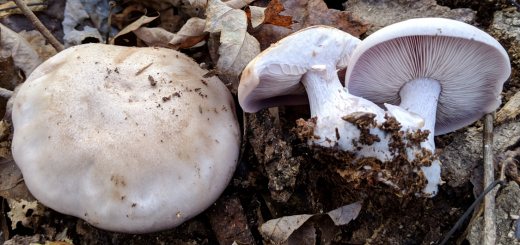
![#013: Characteristics of Phylum Basidiomycota [Archived]](https://www.fungusfactfriday.com/wp-content/themes/hueman/assets/front/img/thumb-medium-empty.png)





![#011: Characteristics of Kingdom Fungi [Archived]](https://www.fungusfactfriday.com/wp-content/themes/hueman/assets/front/img/thumb-small-empty.png)

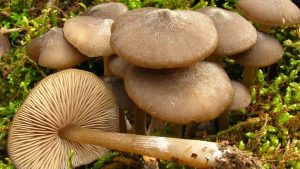
2 Responses
[…] may cause these symptoms include: C. inversa, C. squamosa, C. gibba, and Hygrophoropsis aurantiaca (FFF#196). These mushrooms cause excess blood to be diverted to the extremities (especially the fingers, […]
[…] aurantiaca (FFF#196) is another orange mushroom that grows from wood. The easiest way to differentiate this mushroom […]